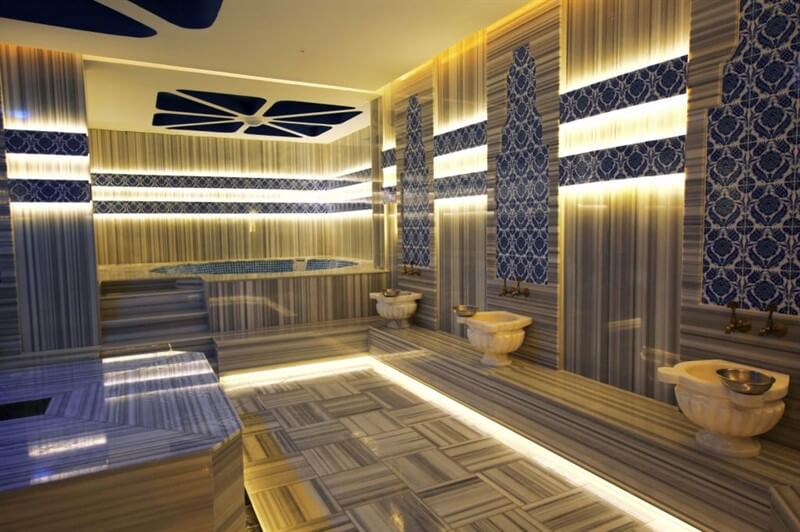
SPA, hammam, and sauna areas are special spaces where guests go to relax, detoxify, and experience mental and physical rejuvenation. However, these areas face two main issues that can disrupt the guest experience:
High humidity and unwanted odors.
These issues affect not only comfort but also the hotel’s image. Therefore, proper humidity and odor control is not only a technical requirement but also a strategic necessity for operating these spaces.
How can proper indoor conditions be achieved in these special areas? Which systems should be used technically? Here are all the details:
1. Excess Humidity: The Hidden Threat Affecting Comfort and Structure
In areas like SPAs, hammams, and saunas, water vapor is intense, and relative humidity can rise to 70–100%. This can lead to:
-
Condensation on walls and ceilings
-
Mold and fungus growth
-
Corrosion and malfunctions in electrical devices
-
Heavier air and difficulty breathing
-
Slippery floors
From the guest perspective: sticky air, steamy atmosphere, suffocating feeling, and shortened SPA experience.
Solution: Dehumidifier Systems
Professional pool-type dehumidifiers or precision humidity control units integrated into central systems should be used in these areas.
When selecting a dehumidifier, consider:
-
The room volume (m³)
-
Steam generation amount (e.g., sauna vs. hammam)
-
Suitability for continuous operation
-
Wall-mounted, ducted, or ceiling concealed installation options
-
Smart models compatible with automation systems
Ideal relative humidity range:
-
SPA areas: 50–60%
-
Hammam and sauna resting areas: 40–50%
-
Steam rooms: can temporarily be higher but should decrease rapidly in adjacent areas
2. Odor Problems: A Factor That Overshadows the Luxury Experience
Along with humidity, odors from sweat, towels, oils, disinfectants, or stagnant water are more noticeable in steamy environments. These odors also create a perception of “uncleanliness” in guests’ minds.
Sources of odor:
-
Insufficiently refreshed indoor air
-
Poorly functioning exhaust system
-
Unfiltered outdoor air supply
-
Bacterial buildup in ducts
-
Backflow from drainage systems
Solution: 4-Layer Approach to Odor Control
-
Activated Carbon Filter
Captures odor particles. Used in exhaust air or indoor air circulation. -
UV-C or Plasma Technology
Eliminates odor-causing bacteria and organic molecules. Can be integrated into air ducts. -
Drainage and Grease Trap Maintenance
Bad odors from showers or wet area floors can backflow; therefore, drainage systems should be cleaned regularly. -
Fresh Air Supply
Indoor air should not rely only on recirculation; continuously supply filtered fresh air.
3. Structural Requirements for HVAC Systems
In SPA and hammam areas, classic air conditioning systems should be replaced with systems designed for high-humidity environments.
Recommended system features:
-
Corrosion-resistant materials on all metal surfaces (e.g., CrNi stainless steel)
-
Duct interiors insulated, preferably with antibacterial coating
-
Low air velocities (no direct airflow on guests)
-
Fans suitable for long-term operation in high humidity
-
Real-time monitoring of relative humidity and temperature via automation systems
4. Smart Control: Balance of Energy Efficiency and Comfort
Continuous ventilation can lead to high energy consumption. However, if systems are connected to automation and operate according to guest usage, both energy savings and comfort can be maintained.
Automation features:
-
Fan activation based on room occupancy sensors
-
Night/day scheduling
-
Airflow adjustment according to humidity and temperature
-
Alerts for condensation, filter blockage, or temperature deviation
5. Periodic Maintenance and Inspection: Prevent Invisible Hazards
The biggest risks in these areas are hidden hygiene problems and microbial buildup. If air ducts, filters, and drains are not cleaned regularly:
-
Bacteria causing odors spread
-
Filters become clogged, disrupting airflow
-
Systems work harder, increasing energy consumption
-
Guest complaints arise due to system failures
Maintenance recommendations:
-
Filter replacement: every 3 months
-
Duct cleaning: every 6 months
-
Condensate pan and drain inspection: monthly
-
UV-C/Plasma system performance check: annually
-
Ozone sterilization: monthly
A Sense of Freshness Comes From Air, Not Just Decor
Even the finest towels, aromatic oils, or architectural designs lose meaning if air quality is poor. True comfort begins in a breathable, fresh, dry, and odorless environment.
Therefore, the proper HVAC investment for these areas should be considered not only from an engineering perspective but also as a brand value that enhances guest satisfaction.
İlker KURAN
Alperen Mühendislik Ltd. Şti.







